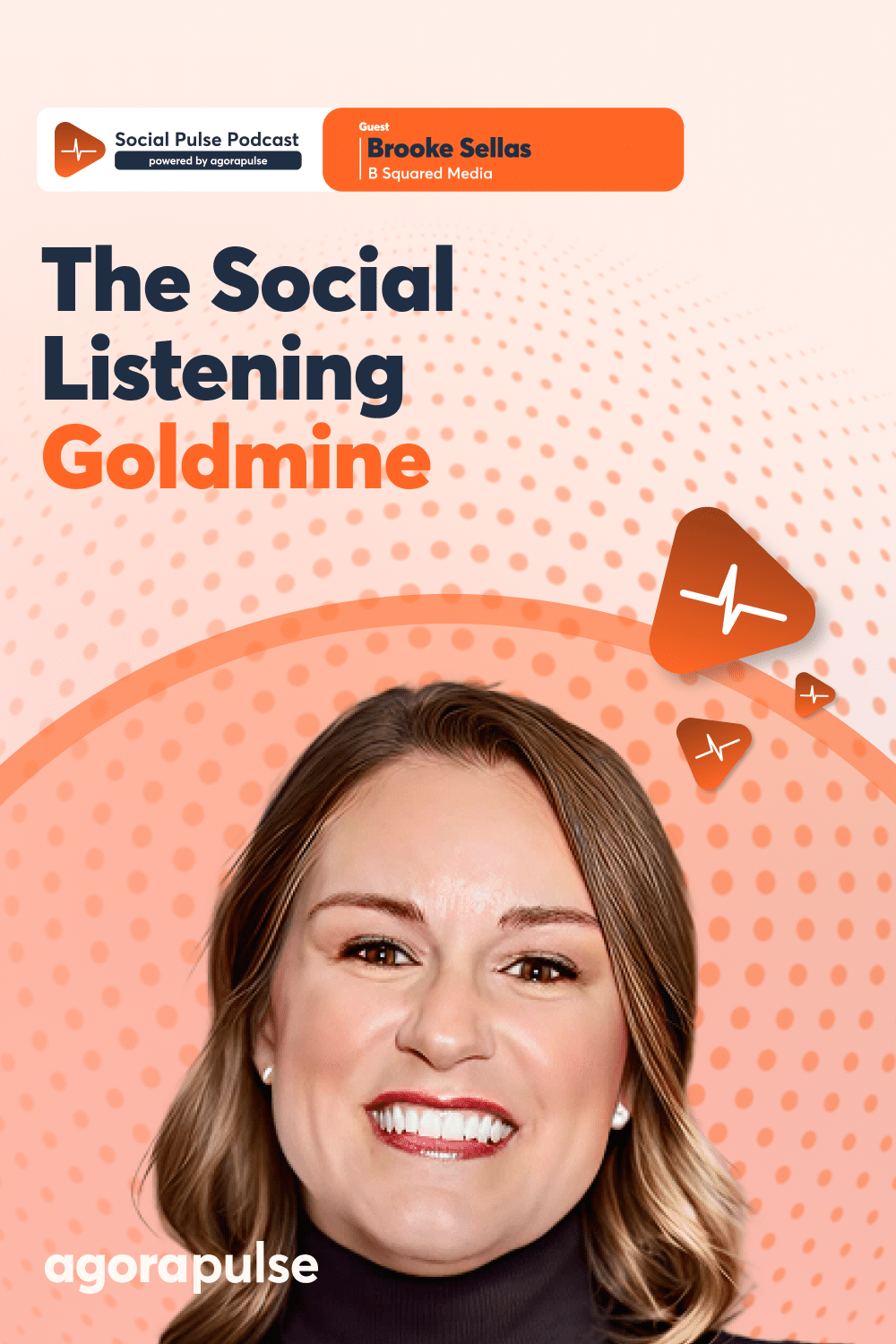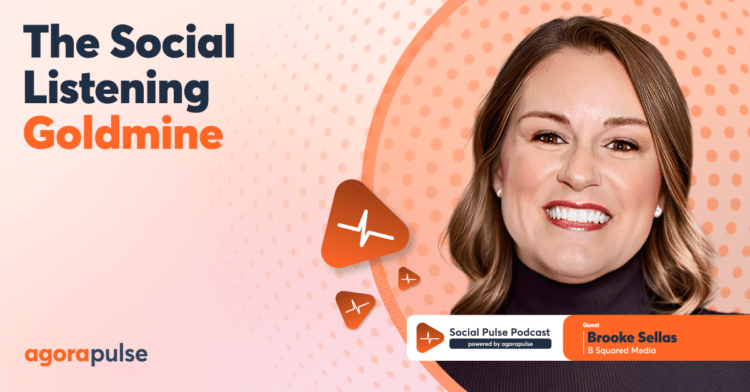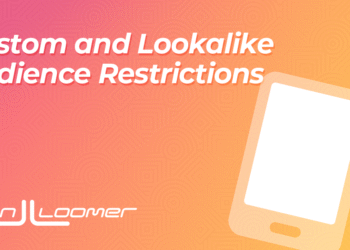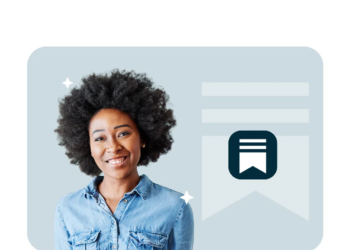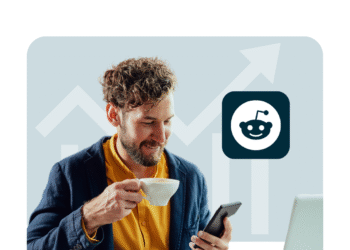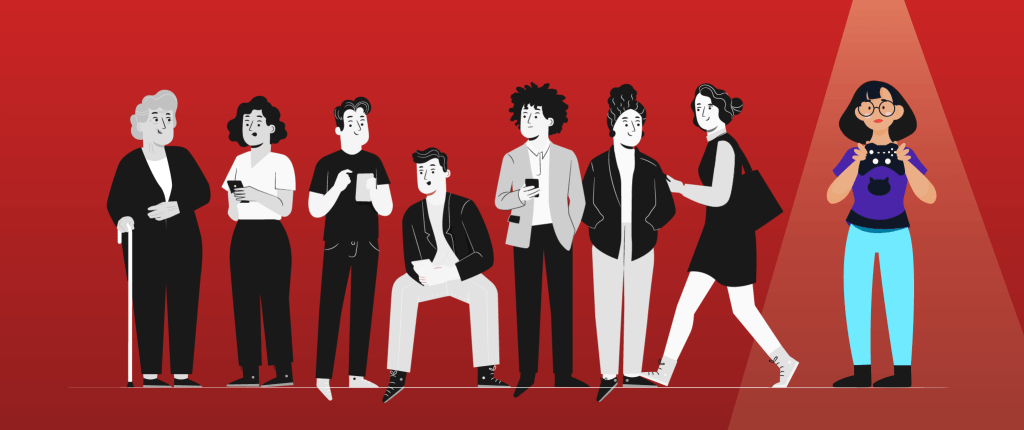Are you treating social listening like glorified brand monitoring? You’re missing a massive opportunity. While you’re counting brand mentions, your smartest competitors are mining social conversations for product ideas, competitive intelligence, and customer insights that directly drive revenue. The conversations happening right now on social media contain a goldmine of business intelligence, from unmet customer needs to competitor weaknesses to emerging market trends. Most brands don’t know how to extract that value.
That’s exactly what today’s guest, Brooke Sellas, is here to help with. Brooke is the CEO and Founder of B Squared Media, an award-winning social media agency specializing in social listening and customer experience. With over 15 years of experience, she’s helped major brands like Michelin, Mastercard, and Coldwell Banker turn social conversations into revenue drivers. Named one of LinkedIn’s Top 10 Rising Stars in Marketing and recognized as a Top 100 CMA Influencer &
Strategist, Brooke is the author of “Conversations that Connect” and has revolutionized how brands approach social listening as a strategic business tool rather than just a monitoring exercise.
Social Pulse Podcast host Mike Allton asked Brooke Sellas about:
- Strategic social intelligence. How to transform everyday social conversations into actionable business insights that inform product development, marketing strategies, and competitive positioning.
- Revenue-focused listening framework. The proven methodologies for connecting social listening data directly to business outcomes like lead generation, customer retention, and churn prevention.
- Competitive intelligence goldmine. How smart brands use social listening to uncover their competitors’ weaknesses, customer pain points, and market opportunities that translate into measurable growth.
Learn more about Brooke Sellas
Resources & Brands mentioned in this episode
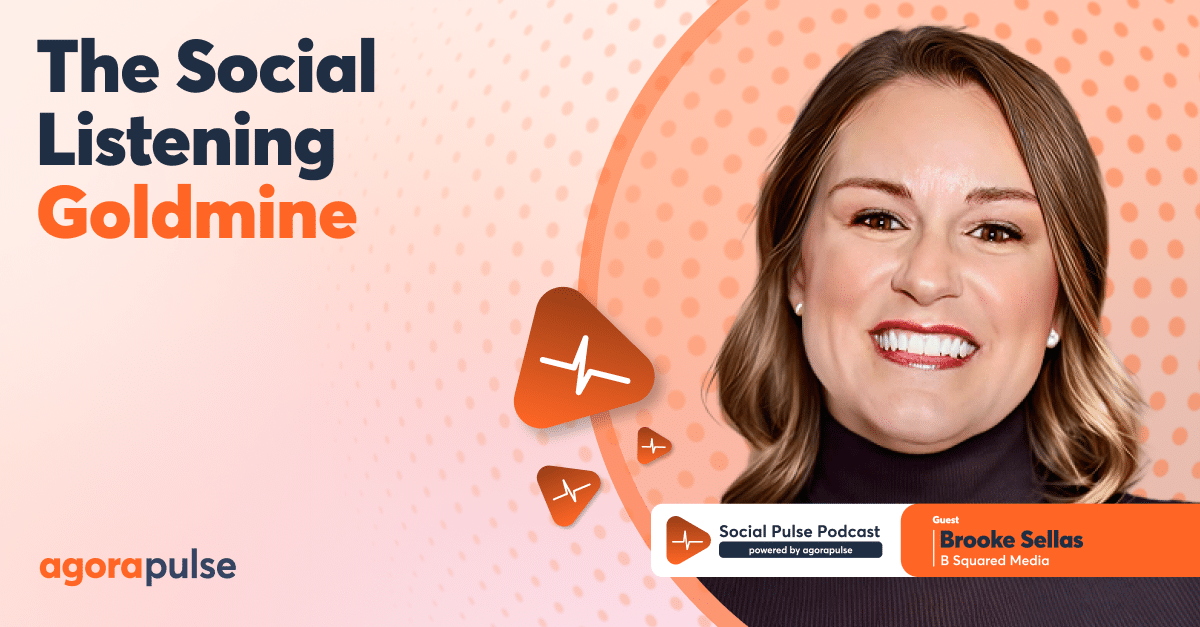
Full Transcript
(lightly edited)
Mike Allton: Welcome back to Social Pulse Podcast, where we’re digging into the challenges, successes, and the stories of social media community professionals in the industry just like you, subscribe to gain valuable insights that you’ll be able to apply to your own work and social presence from each and every episode.
Are you treating social listening like glorified brand monitoring? You’re missing a massive opportunity. Most brands think social listening means tracking mentions and hashtags, but they’re barely scratching the surface of what’s possible. While you’re counting brand mentions, your smartest competitors are mining social conversations for product ideas, competitive intelligence, and customer insights that directly drive revenue.
The conversation happening right now on social media contains a gold mine of business intelligence from unmet customer needs to competitors weaknesses to emerging market trends, but most brands don’t know how to extract that value. But that’s exactly what today’s guest, Brooke Sellas , is here to help with.
Brooke is the CEO and founder of B Squared Media an award-winning social media agency specializing in social listening and customer experience. With over 15 years of experience, she’s helped major brands like Michelin , MasterCard , and Coldwell Banker turn social conversations into revenue drivers, was named one of LinkedIn’s top 10 Rising Stars in marketing, and recognized as a top 100 CMA influencer and strategist. Brooke is the author of Conversations That Connect and has revolutionized how brands approach social listening as a strategic business tool rather than just a monitoring exercise.
Hey Brooke, welcome to the show.
Brooke Sellas: Hey, friend, so glad to be here. What an amazing intro. Thank you.
Mike Allton: Hey, you did all the work to earn that intro, but I’d love it if you could start with just some big picture. When brands say that they’re doing social listening, what are most of them actually doing wrong?
Brooke Sellas: Most people think they’re doing social media listening, but what they’re really doing is social media monitoring, two very different things. So social media monitoring is the basic foundation of social media marketing, right? It’s monitoring what’s coming into us. Meaning if somebody comments on our post, if somebody sends us a DM, if somebody leaves us a review, that is monitoring our social media pages. That’s very reactive, right? We’re waiting for people to come to us.
Social media listening, however, is very proactive.
We’re actually looking for mentions of our brand that are called indirect mentions. So, a direct mention. As I said, you can leave a comment on someone’s post. You can DM a brand, you can add them, right? At Nike . Oh my God, I love my new Air Jordans. That’s an example of tagging Nike. That’s a direct mention.
But if I say, oh my God, I love my new Air Jordans, and I don’t tag Nike, but I’m mentioning one of their top products, right?
This notification does not come to me. Social media monitoring does not cut that. We don’t see that conversation if we’re just doing monitoring. We would actually have to be using social media listening proactively to find mentions.
Of our brand, our products, our stakeholders, our competitors, our industry themes, all of those things that conversations are actually happening around a lot that we just don’t get by just monitoring.
Mike Allton: That’s absolutely right, folks listening. If you’re using Agorapulse, for instance, you’ve got an inbox.
In Agorapulse, for each one of your social profiles that you have connected. But that inbox is only gonna surface dimensions, and the replies and direct messages . It’s not gonna surface like Brooke said, those mentions of your brand that didn’t literally mention you, they just used your brand name or something related, a product, or something like that.
Now, Brooke, I know in some of the other things that I’ve read from you, you’ve talked about how social listening is your secret revenue weapon. Can you walk us through a specific example, maybe of how you’ve turned the kind of social conversations that we’re talking about into actual dollars for a client?
Brooke Sellas: Yeah, so I’m gonna give you the simplest social media listening strategy on the planet. This is what we use for ourselves and our clients. You can steal it. I don’t care if this is a great framework though for everyone. Anybody of any size can use this. It’s called the BIC method. And what we do when we use social listening is we listen for brand terminology. That’s the B.
Industry terminology. That’s the I.
And then the C is everyone’s favorite. That’s competitor listening. But let’s save that in our back pocket for a minute. Let’s just think about industry. I have a client who is a technology consumer technology client. They sell printers, right? So let’s say somebody comes through Twitter or Facebook, I don’t care what platform it’s on, right?
And they say to their peers, which happens a lot on social, Hey. What’s the best printer out there that’s compatible with Alexa, right? Or compatible with voice AI that is sitting out there in the ether? No brand has been tagged. My client has not been tagged. However, if we are looking and using social listening for a keyword phrase like best printer or printers compatible with Alexa, I would be able to surface those conversations using that keyword phrase into my inbox.
That would come to my inbox, and I would be able to then go out and respond as the brand. So it looks something like this. Mike would come out and he would be like, Hey, everybody on Twitter, do you have any recommendations for the best printer that’s compatible with Alexa? Okay. People will come through Brooke’s like Hey, I really love my printer.
It’s a, I have no idea what, yeah, my printer is, I don’t know. Anyway. Oh no, it’s my client’s printers. Oh, I’m just kidding. It’s a printer, right? But then the brand could actually come through and be like, Hey Mike, you might want to check out our X, Y, Z printer and how it is compatible with Alexa.
Here’s a video on how that works. So now I’ve come in as the brand. I’ve listened to this industry term that could help me potentially sell to Mike. And Mike says, Great, I’ll check it out. That’s interesting. It’s not intended. So we’re not social selling yet. We’re just collecting the voice of the customer data, which is still excellent.
But now imagine this is where it gets real with ROI. Imagine Mike comes back from watching that video and something says like, holy moly, this is more incredible than I thought it could ever be. Now we have intent, right? He’s gone from interest to intent. We have an intent signal, and based on that intent signal, if it were my team, we’d be trying to sell Mike.
So what we would do, and this is what we literally do for these clients, is. I would say, Oh my gosh, Mike, isn’t it amazing? Now here’s something even more amazing. I’m gonna give you this code, and whenever you decide to buy this printer, you will get whatever they get is, free shipping, a free ink pack along with your printer, a free paper pack, whatever it is.
And then, when Mike uses that promo code to buy that printer, guess where that money gets attributed. Anyone? Social media it gets attributed to your social care or your social media team. And when your social media teams can start proving attribution and showing actual revenue, guess what happens? We’re not the first to go and the last to come back.
When things get tough, our budgets all of a sudden become wider and broader and bigger because we can prove the acquisition of our social media efforts. Thanks to social listening.
Mike Allton: Love it. You’ve taken them from a cost center to a profit center which is fantastic. The kind of social listening you’re talking about is something of course, we do in Agorapulse, and we do very well.
They do, but another method very well. But another method that you’ve also talked about, I love these acronyms, is your CARE Method™ . Yes, it’s transformed, I think, how brands approach social customer experience. Can you break down that framework and how it connects to the social interactions and business outcomes?
Brooke Sellas: I’m gonna break some brains here for a second. And you know a lot of people, I literally was on a call today. I’m speaking at an event for senior care centers later this year. And I was talking to VPs at these senior care centers and the same thing kept coming up around social media, which is that it’s not the same.
Something about it has changed, and we’re not really sure what that change is, but nothing’s working anymore. And I hear this a lot, and the reason why nothing’s working anymore is because social media isn’t about content anymore. All the content marketers are gonna come for me, but that’s okay. I’m ready.
But it’s about conversation. Social used to be about content. Now it’s about conversation, right? And so we developed this care method for social care and social selling, ultimately, which goes like this. The C is conversations. Your content must. Be conversational. Why? Because it’s a win for you. It’s a win for your potential customers, and it’s a win for AI.
We’re living in a time where zero-click content is huge. 60% of people don’t click anymore. They don’t have to. How do you fight that? Conversational social media content is one of those ways. So happy is now. Conversational content on social media. So those conversations are what start this flywheel.
Now, as we’re having these conversations, and hopefully we’re not just doing it reactively, right? We’re using social listening to help us get proactive. Then, as we start to enter these conversations, like the one that I talked about with Mike, we’re labeling these conversations. Is this an acquisition conversation?
This conversation with Mike was an acquisition conversation. I would’ve labeled it as. Such, right? Even before Mike showed intent, I’m like, there’s potential here. He’s asking about a product that we can sell to him. In your case, it may be a service, but either way, if somebody’s asking for something that you sell, that is acquisition, that is again, sales support question, and I would label it that way. That’s the a, the other side of that coin is retention. A lot of what people do on social media, I’m sure you know this, is they come and they complain, right? These are your moments of churn. You have to stop churn. It’s more important to stop churn than to gain. I don’t know why this is so hard for people to understand, but.
That’s another conversation for another day. So now I’m looking at these conversations that people are having, these comments, they may be negative, very well be negative, but they’re showing me customer support, retention. These are my churn moments. These are my moments where I need to win the customer back over.
So I’m gonna tag that conversation as retention, right? So now I’m quantifying everything that’s happening on my social media channels. In the way of proving revenue and business outcomes, this is what CEOs and C-suites, and stakeholders want to see. They want to see social providing business outcomes.
This is how you do that.
Then the last little letter is E, and that’s engagement.
And you may be thinking, Brooke, you said conversation in the beginning. So what’s the difference between commitment? We need the conversational content. That’s the entry point. We know we have to be labeling these conversations, but we need that engagement to get deeper because real deep engagement isn’t likes, it’s not comments that are like this or fantastic.
It’s comments like, here’s my opinion about the subject, right? Your industry or your brand, your product, or your service. Here’s my feeling about your competitors. This little flywheel of care is what helps you get to ROI with social media, but you have to be using social listening to do it right.
Mike Allton: That’s fantastic. And of course, I love that you mentioned tagging. That’s something folks can do in Agorapulse, so you can tag the comments and conversations. So we’re creating conversational content and listening to responses. We’re setting up searches to listen for conversations that we didn’t initiate, that we aren’t tagged in, but we might want to get into.
I know from experience. This can generate a lot of noise, particularly if you do something like, oh, let’s set up a listening search for our top competitor. Wow. You’re gonna be overwhelmed. With noise. Yeah. How do you identify which social conversations actually have revenue potential versus the ones that really are just noise?
Brooke Sellas: Yeah … we have intent tagging system that we use. I have this blog post by the way on this, which I’m happy to share with Mike to put in the show notes. But you’ve gotta be looking for intent signals. But let’s take your example, Mike, of the competitor listening.
The first thing I do, I literally just did this with Agorapulse on a giant healthcare brands audit, we were doing an audit of their social channels, and we were looking at their competitors who have way more spend than they do. And that feels like it’s hard to be the small player on the field, right? So we went and we looked at all of their competitors’ ad spend, obviously way outspending us, but they weren’t doing anything on organic.
Almost nothing, spending all this money on paid and then nothing on organic, which was a huge opportunity for us. But even more than that, when we started to dig in on competitor listening, we looked at the negative conversations first, and it discovered a huge playing field of opportunities for us and what we call differentiated campaigns.
So a lot of it was like you say, you accept this healthcare, and you don’t. That’s a huge place for us to be like, Hey, by the way, when we say we accept X, Y, Z, healthcare, we mean it. That’s huge because now you’re talking about stealing market share away from your competitors based on what their customers hate about them.
It’s so simple, but it as Mike knows, you get in there and you do this strategy work and all. That’s not quite that simple. But it can be if you’re using an amazing social media listening tool and you know what you want out of that listening tool, right? I have a strategy, I know what I’m trying to do.
I’m gonna start with that C at A BIC, even though I think you should start with branch, whatever, start with C, but then look at the negative conversations. See what they’re saying. Let’s go back with Nike. Let’s say we’re Nike, and we look at a competitor, and that their top complaint is that the shoelaces on the running shoes break every 30 runs. And it’s that’s ludicrous, right? They should last longer than that. Couldn’t I, as Nike, run a differentiated campaign?
Targeting that company’s group, especially through social and retargeting these options that we have, and say something about athlete tested, have one of our athletes on the screen, like I’ve run 200 races and I still have the same laces that the shoes came with. That’s the power of social listening from a differentiated campaign and competitor listening.
Mike Allton: Love it. And for folks listening, when Brooke talks about positive versus negative, what she’s talking about is sentiment analysis. So you want to make sure that whatever tool you’re using for social listening has that in place.
They’re using, hopefully, AI to analyze the sentiment of every single comment, post reply, whatnot, and give you that quick indicator, oh, this is positive, this is negative, this is neutral. Great point. And you can use that to help drive your strategy.
Folks, we’re talking with Brooke Sellas about the importance of social listening. In a moment, we’re going to dig into some specific examples and recommendations, but first, let’s make sure that you and your team actually have enough time available to do this kind of important work.
Advert: When I take a look at the biggest core benefit for Agorapulse, I have to look at two sides of the equation. I have to look at what it does for us as far as managing our community and all of the conversation management tools, which I appreciate so much, but from a far more pragmatic point of view, it saves us money.
It saves us a lot of money because of the productivity of the features that are built in, with how it manages those conversations. We don’t waste time. We’re efficient.
Agorapulse allows me to get through all my messages and my replies really quickly. That’s probably the number one. A reason for me wanting to use the tool, it, it saves so much time.
A big draw for me with Agorapulse was the ability to manage my YouTube comments. That is a huge feature for me, and here’s why: because up until then, I basically would have to go into my social media manager system to do everything there. And then I’d have to log out, go back into YouTube and do the same thing there.
Now, when you are managing multiple clients. This becomes a huge waste of time, right? And what we want to do is streamline that efficiency so we can log into one website. Now we can manage all of our major social profiles there, and we’re able to serve our clients with more clarity and purpose. They worked with us.
They helped train us on how to get everything up and going, and we were able to cancel out all the other tools that, we didn’t need anymore. So it saved us a lot of time and a lot of headaches for my team members as they’re now they only using one tool that they can maximize for their clients.
Mike Allton: Brooke, I’ve heard you say that competitors are essentially telling you how to beat them through social media. Can you give us some other examples of competitive intelligence goldmines that you’ve discovered?
Brooke Sellas: Yeah. It’s, this audit is another great place ’cause I guess it’s fresh on my mind ’cause we literally just presented the presentation last week.
But wow. If you are spending millions of dollars, if you’re spending any dollars, I don’t care how big or small you are, and you’re not using organic social media and tandem with that paid, you are leaving yourself open for disruption from your competitors. Yes, we can’t outspend our biggest competitors, but if you think about the way I’ve described the conversations that are happening on social, and by the way, let’s back up here, right?
80 something percent. I want to say the status 81% of customers, 81% of US social media users, make impulse purchases through social media monthly. 81%. Think of how many social media users there are now. Imagine 81% of those people making impulse purchases monthly on social, come on. People are spending huge amounts of time on social media to research new brands.
The younger generations, Gen Z and younger, they’re actually waiting for that brand conversation as high or higher than online reviews. So again, new generations we’re, the social media isn’t the same anymore. It’s not about content, it’s about the conversation. And so if we’re looking at these competitors, and we’re looking at the sentiment, as Mike mentioned, around their brand, which is the positive, the negative, the neutral, if there’s no conversation happening.
You’re literally opening yourself up for your competitors to come in and have a conversational strategy and beat you out because that’s where people are looking. Think about what AI is doing, right? If we are not clicking. If we are going to Google and we’re searching for something and the AI surfaces, those answers at the top right, those AI, we don’t have to click on anything.
The answer’s right there. I want you to start to pay attention to who the AI is recommending over on the side. Oftentimes, it’s brands that have the highest social signals or have the most video content like we’re doing here, right? It’s looking for. I guess
I would call it at a PR moment. Yes, you could do a PR play, which is very expensive depending on who you are, but you could also just start to put out conversational content on your social media channel and start to maybe get yourself moved up higher in an EO situation.
Answer engine optimization, which is like the term that we’ve been using for the AI answer. So I think looking at your competitor’s positive sentiment would be my next step. And figuring out what people love about their brand. What are the positive conversations that are happening around their brands, and how can you compete and should you compete.
I guess a lot of times, Mike, what we find when we’re doing these competitors listening analysis is that competitors, the competitors you think are your competitors aren’t really your competitors, right? They’re not actually adjacent to your brand. They might be, oh, wow, I hope to be that level someday.
But if they’re spending a million dollars a month and you’re spending $5,000 a month on advertising, they’re not really a competitor. And a lot of times, what we’ll see in those conversations is that their problems are much different or their conversations are much different. Look for the language that the customers are using.
Both with your own brand in the b also in the i in the industry and on your competitors. So if you’re calling something, we did a big listening campaign for a credit union. Overdraft protection fees, if you’re calling it an overdraft protection fees program or whatever it is. And they’re just calling it like overdraft fees.
Then you need to think about mirroring the language that your customers are using with your competitors, and also obviously with your own brand. There’s just, how deep do you wanna go down this rabbit hole? There are so many things.
Mike Allton: Yeah, no, but this is really insightful because most of the conversations that I have had around social listening are, look for keywords, and that sort of thing.
We haven’t really gotten to that point of… really think hard about who you believe your competitors are and who your competitors really are. And pay attention to the language that your customers and your prospects are having. You can do, obviously, social listening to help you with that, or you can just pick up the phone or get in a Google Meet or a Teams call and talk to your customers and listen to them. Listen to the Gong calls . Hopefully, you’re using Gong or something similar and you’re recording your sales calls. You can listen to them as well, I hope. Yeah. So there’s a lot of listening that has to happen.
Not necessarily always on social media, but the point is to think about and pay attention to,
Brooke Sellas: Right? Yeah.
Mike Allton: Who you should be talking to, who you should be talking to them, and what you should be talking to them about, and the language you should be using. What are some other like overlooked opportunities that you think brands are right, they’re just missing when they’re analyzing the social conversations?
Brooke Sellas: A lot of brands want to obviously start with the B, which makes the most sense, right? We need to know how we’re doing as a brand, right? How do people feel about us? What are people saying about us? What’s the feeling? Is it good? Is it bad? Is it neutral? What? Neutral by the way, not good. So actually, it’s all just good and bad in my opinion, but that’s another story for another day also.
So brand is great. But I do feel like industry is also really important because what happens when you start to listen to terms in your industry is that you start to identify trends and patterns in a microcosm kind of way. And you know it’s happening a lot faster where you start to. What’s the help of AI in identifying these trends and patterns so that you are the first to break news?
The example that I think of is we’ve all seen those people on LinkedIn who always get their articles featured, right? They’re people, but they wrote about some big news thing that’s happening, like with Salesforce or whatever, but then their articles featured, it’s like being that person.
You’re being so on top of the trend. You’re the first one to curate it and talk about it, and explain it from your point of view or your customer’s point of view, even better. That you become the leading resource for them. So not only are they now coming to talk with you, but they also want to come check in with you all the time because you are that leading resource of what’s happening in that industry. Does that make sense?
Mike Allton: Yeah, absolutely. So yeah, you’re doing great content marketing, of course, newsjacking, but also making sure that when you’re doing it, it’s with your customers and your target audience specifically in mind, goes back to making sure you’re doing that research in advance.
Let’s talk about product opportunities or market gaps, because I think social listing could be fabulous. For identifying these kinds of things. If a brand’s listening or social media manager wants to look at that, how would you structure their social listening?
Brooke Sellas: That’s a great question. So again, I think this is an industry play for marketing gaps, and this is where I start to rely on AI pretty heavily.
The tools use AI, right? Most social listening tools use AI, and that’s fantastic, but I would even take it a little bit further. So for me, and this is why, by the way. Trying to, when you’re putting together these listeners, especially for the bigger terms, like industry terms, right? You’re talking about information that’s coming to you through a fire hose.
It’s so much data, which is wonderful. That’s the most amazing part of social listening. But then being able to separate the signal from the noise when it comes to social listening can get really daunting, especially when you’re an agency like me and you’re doing your own social listening more than of all of your clients, right?
So what I like to do. You can use any LLM of your choice, right? I happen to use ChatGPT . I have a bot specifically that’s set up with priming around social listening, and I just talked to that bot about it. Here’s what I’m seeing. Help me do a gap analysis. That’s a great prompt. Ask for a. Gap analysis in the data report.
You can just upload like a CSV if you’re using a pro account on chat, GPT ask for it to spot what micro trends and patterns you’re seeing based on the conversations. By the way, you can do this with your own conversational data, so those sales calls that Mike was just talking about. Please get some transcripts of those if you don’t already have them.
Upload those into your LLM of choice and say something like, tell me what the top trends are. What are the top trouble spots? Where do we need to focus? What’s our easiest road to fix something that is a constant problem, right? Because we don’t just wanna solve the problem for that customer at that point in time.
We want to solve the problem period so that nobody else has to come back and complain about it. So this is the part where I rely really heavily on my favorite Brookebot , who’s my custom GPT, who’s been around for almost two years now. I really rely heavily on that LLM to help me with the gap analysis.
Because I’m not a math person. Everybody hears me say this, right? I’m more of a creative, but sometimes it just takes AI helping you extract that signal through the noise because it is a lot of data. So that’s my cheat code for understanding what’s happening around marketing gaps or places we can enter.
Mike Allton: I love me a good content analysis. I had Andy Crestodina , a mutual friend, on my other show who walked me through using AI for that. It never occurred to me to pour data from social into that, which is fantastic. I love that we’re talking about focusing on conversational. We’re adding Reddit support to Agorapulse, obviously, all about the conversations.
Brooke Sellas: Don’t sleep on Reddit.
Mike Allton: Don’t do it. Terrific. And I know we’re just touching the surface on all this it’s all we can do in a brief podcast, but I’m wondering, are there specific tools or resources that you rely on to just to stay ahead and keep up with the social listening space? Where do you go to learn about some of these emerging trends and best practices you’ve been talking about?
Brooke Sellas: Obviously it goes without saying that I love and have used Agorapulse for a long time. Are we allowed…is the news out about Mention? Am I allowed to say that?
Mike Allton: Yes, you can say that.
Brooke Sellas: Okay. So if you haven’t heard, Agorapulse recently acquired Mention , which is a social listening company that I have been recommending literally in all of my social listening talks for like a hundred years ’cause I’m a dinosaur.
But now, Mention is a part of Agorapulse. So they have social listening on steroids. We literally used this tool through Agorapulse with that healthcare audit that I was just telling you about, and. pH mind blown explosion. Amazing. Really powerful tool that they have under the hood now at Agorapulse.
So find yourself a tool. He doesn’t listen. I always say I love my partners, I love my tools. I love my buddy Mike, but I really have to be tool agnostic, ’cause sometimes we have clients who come to us with their own suite of tools and we need to sit on those tools, right? So I’ve used a ton of different tools.
But here’s the number one thing I would say, if you’re. If you’re shopping for a social listening tool, you need to know. What you are trying to do before you demo the tools, and here’s why you need to be able to get on that demo and say to Mike, Oh Mike, I’m, you’re now the mentioned demo person. But I, you need to be able to say, Mike, I heard this amazing podcast from Agorapulse with Brooke, and she mentioned this.
BIC listening strategy , and that’s what I want to do. I wanna set up brands, listeners, I wanna set up industry listeners, and I wanna actually dig into this competitor who’s been killing it, and I wanna find out why and how we can match and maybe steal some of that market share back. Then Mike is going to be able to show you how the tool can do those things.
If they can’t show you how the tool does those things, it’s time to move on to the next demo. These are powerful, not inexpensive tool, so you have to know. What outcome with this tool needs to be before you decide to sign up for one of these tools and pay whatever it is every month?
You’ve gotta know what you gotta do. If you need help with that, I say read up on social listening. I’ve got a free social listening workbook I can send you, I can talk to you through it, whatever. I’m just saying. Don’t get a social listening tool, ’cause it’s so cool. I get it. I’m like a data lover, and you’re like, oh my god, that sounds so amazing.
But it’s so powerful and there’s so much data that you can get behind your queries that you’re gonna set up. Oh, and by the way, setting up queries and knowing how to do a bullying search and all that stuff, that’s all needed. So take a beat. Plan a strategy. Call Mike on the phone, send him a LinkedIn message. Get your plan for what you want to do, then go and start demonstrating your tools.
Mike Allton: I’ve been nodding my head the entire time because not only is this great advice for social listening, but quite frankly, all of you listening need to take what Brooke just said to heart about every MarTech purchase you’re considering.
Yeah. Yeah. I tell people the same thing about ChatGPT. I said before you even open ChatGPT, understand what your business challenges are, what you’re spending a lot of routine time on, because then you’ll know what to use, potentially ChatGPT, to help you fix. Yeah. It’s the same thing with social listening. Anything else? Brooke? You’ve been absolutely amazing. I know folks have more questions. They have to. Where can they go to reach out and connect with you?
Brooke Sellas: You can find me on LinkedIn ; that’s where I hang out. I’m pretty active there, so if you want, like, literally chit chat with me about social listening, come find me on LinkedIn, Brooke Sellas, I also have my own website, brookesellas.com, which is all for my like speaking training stuff. And then our company website is Bsquared.media . It’s not a .com, so it’s dot media. I think you can Google me. I’m pretty sure I’m the only Brooke Sellas out there.
Mike Allton: I think I’m still gonna have to find out, but you’re the only one I’ve ever known, that’s for sure.
Brooke Sellas: I think so. So just Google me. I’m there. Send smoke signals. I’ll come running.
Mike Allton: Don’t worry, we will obviously have all of Brooke’s links in the show notes below. But thank you, Brooke. Thanks to all of you for listening. That’s all the time we’ve got. Don’t forget to find the Social Pulse podcast on Apple.
Drop me a review. Let me know what you thought of this episode and what you thought about Brooke. Don’t tell me what you thought about me. I don’t. I don’t want to know, but let me know what you thought about Brooke, and please join our exclusive community on Facebook Social Pulse community . You’re going to be able to network with terrific podcast guests like Brooke, as well as literally thousands of other social media marketing professionals in the industry.
Until next time.
